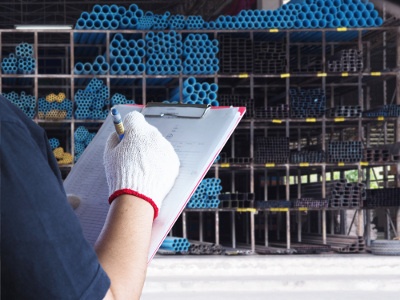 How much time do you spend finding and fixing defects after they appear in your products?
How much time do you spend finding and fixing defects after they appear in your products?
If you’re like many importers, the answer is probably “more than I’d like”. Addressing quality defects after mass production often takes up valuable time right before a shipment deadline. Ordering replacement materials or components, manufacturing replacement units, conducting product rework and re-inspecting can all delay shipping when time is most critical.
Many importers rely on pre-shipment inspection to manage product quality. But if you’re just relying on inspection to help you identify and address quality defects in your products, you’re already playing catch up. Waiting until after production to address quality defects often means quality defects that could have been prevented now affect a large portion of your order.
As in many things in life, the old adage “a stitch in time saves nine” rings true when it comes to managing product quality. By taking just a few preventative steps before production, importers can often see a marked decline in the number of quality defects in their shipment (related: How Experienced Importers Limit Product Defects in 3 Stages [eBook]).
Sound too good to be true? Let’s take a look at four of the most important steps for preventing quality defects and how they might help you manage product quality.
1. Audit potential suppliers’ quality management systems
Many importers prefer to work with suppliers that have ISO 9001-2015 certification because they feel it gives them some assurance of production capabilities and quality control processes.
But just because a factory has an ISO 9001 certificate doesn’t mean they’re actually implementing the practices embodied in the standard. For example, in parts of Asia a factory might be able to obtain certification through lax registrars or by bribing auditors.
 A quality audit, or supplier review, is a systematic examination of a factory’s quality management systems (QMS), usually against ISO 9001 standards. A supplier review can give you valuable information on a factory regarding:
A quality audit, or supplier review, is a systematic examination of a factory’s quality management systems (QMS), usually against ISO 9001 standards. A supplier review can give you valuable information on a factory regarding:
- Personnel training, including checking whether employee training includes educating personnel about specific defects related to their role
- Purchasing, including checking procedures for evaluating and approving sub-suppliers and setting acceptance requirements for production inputs
- Production and process control, including checking work instructions, workmanship standards, production equipment, environmental controls, cleanliness and contamination control
- Inspection, measuring and test equipment, including checking proper calibration of tools and equipment to ensure accurate measurements and results
- Acceptance, identification and traceability activities, including checking records and procedures for incoming inputs and material, in-process and final product quality control
- Nonconforming product control, including checking procedures for marking, identification, evaluation, separation, disposal and rework of nonconforming or defective products
- Labeling, packaging, handling and storage, including checking procedures to ensure protection from product mix-ups, damage, deterioration or contamination
- Quality records, statistics and analysis, including checking procedures for sampling, defect collection, corrective and preventive action and handling customer complaints
How can a quality audit help you prevent quality defects?
Many importers conduct a quality audit as part of the qualifying process before they begin working with a supplier. The information gathered in a quality audit can help limit your risk of working with a “bad” supplier incapable or unwilling to meet your production standards (related: 5 Qualities of a Good Supplier).
A factory’s internal quality control procedures are critical for managing incoming and in-process quality control—QC processes that are often out of your control. Many suppliers purchase raw materials, components and packaging from sub-suppliers long before their customer gets involved with managing product quality at their facility.
Some “red flags” or signs of poor quality management that a supplier review might reveal include:
- Lack of formalized incoming quality control procedures or processes for vetting sub-suppliers
- Lack of documentation and records, including business licenses, QMS certificates, internal audit records, production flow charts, work instructions and corrective and preventive action reports
- Inadequate training for factory workers and lack of training records
But you’re not limited to conducting a quality audit only when choosing a supplier—you can conduct a quality audit at any stage of your importing journey. If you’re experiencing serious quality issues, an audit can also help expose deficiencies in the factory’s production or QC processes that might be responsible for quality defects.
2. Set the right price for your quality level when negotiating with suppliers
It’s hard to manufacture a quality product without using quality materials and parts. No matter how well designed a shirt is, the design can’t overcome the use of poor quality fabric, for instance. And a slick new smartphone manufactured with the wrong camera or display will likely lead to unhappy customers and product returns.
Negotiating an unreasonably low price for your order poses serious risks to the quality of your finished goods (related: Top 5 Tips for Negotiating with Chinese Factories). Like most importers, factory managers tend to be very conscious of their costs to ensure profitability.
Many suppliers will happily accept a lower price for your order. But this lower price almost always comes at the cost of product quality. This can materialize in a number of ways, such as:
- Using cheaper raw materials than initially agreed to
- Substituting lower-cost alternatives for product components
- Rushing production to process your order faster, often leading to a higher defect rate caused by worker carelessness
You typically won’t discover these issues until you perform a quality control inspection after production. At that point, it’ll be too late to prevent quality defects from arising. Instead, you may now have an order of unsellable goods with quality defects you’ll need to address before shipping (related: 4 Ways to Address Product Defects Found During QC Inspection).
How to get the best price without forsaking product quality
Just because lower prices often mean lower quality doesn’t mean you’re trapped into accepting whatever price the factory offers you. Some best practices for getting the best price for your order, while still minimizing product defects, include:
- Comparing price quotes: Ask for price quotes from multiple suppliers to learn what a typical price is for your product and whether a potential supplier’s quote is competitive.
- Asking suppliers for a bill of materials (BoM) and itemized pricing: A BoM is a list of raw materials, sub-components and parts used in manufacturing an end product.
- Providing an order forecast for stock materials: Especially for materials where the market price is subject to substantial changes over a short period, like aluminum, steel or microchips, buying stock material in bulk can help reduce input costs.
- Modify product design: Often the more complicated procedures in production and the more components needed, the more expensive the product will be to manufacture.
3. Establish a golden sample to set quality expectations
One of the best ways to check if a supplier is “all talk and no action” is to request a product sample before production. Creating a product sample will require the factory to actually demonstrate they’re capable of manufacturing to your desired quality standard.
Verifying sample quality when choosing a supplier can help you decide whether a price quote is appropriate for the quality level of the actual product. But even if you’ve already chosen a supplier, you should still request and review a product sample. A product sample is invaluable for setting quality expectations before mass production to prevent quality defects (related: How Importers Minimize Product Defects by Establishing a Golden Sample).
A golden sample offers an opportunity for you to provide feedback to your supplier and resolve any quality issues before production regarding:
- Parts and materials used
- Adherence to product specifications
- Proper functionality and performance
- Packaging designs, branding and artwork
After you’ve reviewed and approved it, your product sample becomes a “golden” sample. Factory staff can then use your golden sample as a model for reference during production. The golden sample sets the standard for quality so workers can take corrective action of their own volition when quality issues arise during production. This helps prevent quality defects from affecting a large portion of the finished goods.
How to review a golden sample for conformance to your standards
You may be able to review your product samples on your own without any complex equipment or tools. Most importers just need to check the product according to their specifications and test any functions to simulate actual product use.
 But depending on product use and applicable regulations, some importers might also want to test samples in a certified lab. Many products require testing for conformance to a particular international standard or legal regulation in their intended market of sale. Such testing might include:
But depending on product use and applicable regulations, some importers might also want to test samples in a certified lab. Many products require testing for conformance to a particular international standard or legal regulation in their intended market of sale. Such testing might include:
- Safety testing
- Product performance and durability testing
- Material composition and purity testing
- Comparison testing, or benchmarking, usually against a competing product’s performance
- Packaging testing
You might be thinking shipping a product sample from your supplier to your home country sounds costly and time consuming. This might be particularly true of large products like home appliances, furniture or industrial goods. A third-party inspection company can often review samples for you, either at their local office or at your supplier’s facility itself, cutting down on transportation cost and time.
When hiring a third party to review your product samples, make sure you provide all the relevant product specifications and requirements for your product. This helps the third party accurately assess the sample just as you would.
After reviewing the sample, make sure the third party sends the sample back to the factory for reference. Any sample you intend independent inspectors to use should also be marked and sealed as a golden sample. This helps prevent factory workers from potentially tampering with or replacing the sample with another unit (related: 3 Must Do Procedures for Handling Golden Samples for Manufacturing).
4. Set your tolerances for quality defects in a quality manual
A golden sample shouldn’t be the only resource factory staff reference during production. In fact, the main resource for factory staff regarding your requirements should be a quality manual, or quality control checklist, you provide your supplier (related: 5 Essentials of a QC Checklist [eBook]).
 Some importers simply email a bulleted list of requirements or send a number of different documents to their supplier. The benefit of using a quality control checklist you’re combining your requirements into one comprehensive, yet easy to reference, document. QC checklists for simple products usually range from 3-10 pages in length, while checklists for more complicated products with extensive testing might be longer.
Some importers simply email a bulleted list of requirements or send a number of different documents to their supplier. The benefit of using a quality control checklist you’re combining your requirements into one comprehensive, yet easy to reference, document. QC checklists for simple products usually range from 3-10 pages in length, while checklists for more complicated products with extensive testing might be longer.
An effective quality manual includes relevant information for factory and inspection staff, including:
- Product specifications
- Your tolerance for quality defects
- Product inspection requirements, including on-site testing the product will be required to pass
- Packaging requirements, including shipping and retail packaging
Production or QC staff at most reputable factories should have developed their own quality manual for the products they manufacture there. But these workers often adapt their quality manuals to broadly apply to multiple customers, sometimes omitting your specific tolerances for quality issues.
Ideally, you should send your QC checklist to your supplier before production to prevent quality defects related to misunderstandings about your requirements. One of the most common causes of quality defects is simply a misunderstanding about what you wanted in the first place.
After sending your QC checklist to your supplier, ask them if they have any questions about your requirements. You might need to be persistent in asking for questions. Local cultural norms sometimes prevent factory staff from asking questions on their own or otherwise admitting uncertainties with your product (related: 3 Cultural Barriers You Must Face for Effective China Quality Control).
How can a third-party inspection company help with quality manuals?
If you’re already using a third party for routine inspections, you might find the same inspection company can help you with your checklist at no added cost.
Third-party QC providers often have a better understanding of inspection procedures and QC checklist techniques than the importers themselves. This might include knowledge of:
- On-site testing procedures, including which tests are relevant for your product and what equipment is needed
- Inspection sampling protocols, which often entails using a standard like ANSI ASQ Z1.4 to pull a statistically significant random sample
- Defect classification procedures, including how to issue a “pass” or “fail” result for the inspection based on defect type and number found
Be sure to also consult your supplier when developing your QC checklist. Your QC checklist won’t be very helpful in preventing quality defects if the factory can’t meet the quality standards outlined in it in the first place.
However, only you know that’s best when it comes to your tolerances for quality issues and your product specifications. For example, it’s important when reviewing golden samples to provide any third party with all the relevant information needed to develop the most appropriate and helpful document possible. Your golden sample could otherwise misrepresent your product requirements.
Conclusion
As an importer, you can manage product quality through pre-shipment inspections (related: How Quality Control Inspection Helps Importers Detect Product Defects). But at best, these inspections can only help you identify and address quality defects, not prevent them. And it’s usually easier and more efficient to prevent quality defects through the above methods, rather than try to fix defects after they’re already apparent in your product.
But just as you can’t only conduct quality control inspection without preventative actions, you also can’t just take preventative actions without conducting inspection. Most importers will still want to conduct a pre-shipment inspection after production, typically when the order is 80-100 percent complete.
Both preventative measures and product inspection are recommended for a complete quality control program.
Click the button below to read or download our comprehensive eBook and learn how to prevent, identify and address quality defects in your shipments!







